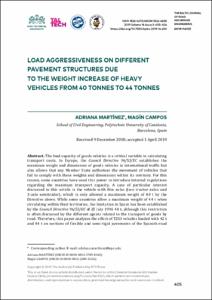Mostra el registre d'ítem simple
Load aggressiveness on different pavement structures due to the weight increase of heavy vehicles from 40 tonnes to 44 tonnes
| dc.contributor.author | Martínez Reguero, Adriana Haydée |
| dc.contributor.author | Campos Cacheda, Jose Magin |
| dc.contributor.other | Universitat Politècnica de Catalunya. Departament d'Enginyeria Civil i Ambiental |
| dc.date.accessioned | 2019-10-15T09:55:05Z |
| dc.date.available | 2019-10-15T09:55:05Z |
| dc.date.issued | 2019-09 |
| dc.identifier.citation | Martinez, A.; Campos Cacheda, J.M. Load aggressiveness on different pavement structures due to the weight increase of heavy vehicles from 40 tonnes to 44 tonnes. "Baltic journal of road and bridge engineering", Setembre 2019, vol. 14, núm. 3, p. 405-424. |
| dc.identifier.issn | 1822-427X |
| dc.identifier.uri | http://hdl.handle.net/2117/170097 |
| dc.description.abstract | The load capacity of goods vehicles is a critical variable in calculating transport costs. In Europe, the Council Directive 96/53/EC establishes the maximum weight and dimensions of goods vehicles in international traffic but also allows that any Member State authorises the movement of vehicles that fail to comply with these weights and dimensions within its territory. For this reason, some countries have used this power to introduce internal regulations regarding the maximum transport capacity. A case of particular interest discussed in this article is the vehicle with five axles (two tractor axles and 3-axle semitrailer), which is only allowed a maximum weight of 40 t by the Directive above. While some countries allow a maximum weight of 44 t when circulating within their territories, the limitation in Spain has been established by the Council Directive 96/53/EC of 25 July 1996 40 t, although this restriction is often discussed by the different agents related to the transport of goods by road. Therefore, this paper analyses the effect of T2S3 vehicles loaded with 42 t and 44 t on sections of flexible and semi-rigid pavements of the Spanish road network, to provide information about the impacts of the modification of the regulations on capacity. |
| dc.format.extent | 20 p. |
| dc.language.iso | eng |
| dc.rights | Attribution 3.0 Spain |
| dc.rights.uri | http://creativecommons.org/licenses/by/3.0/es/ |
| dc.subject | Àrees temàtiques de la UPC::Enginyeria civil::Infraestructures i modelització dels transports::Transport per carretera |
| dc.subject.lcsh | Pavements, Flexible--Live loads |
| dc.subject.other | Flexible pavements |
| dc.subject.other | Heavy vehicles |
| dc.subject.other | Maximum permitted weight |
| dc.subject.other | Pavement design |
| dc.subject.other | Semi-rigid pavements |
| dc.title | Load aggressiveness on different pavement structures due to the weight increase of heavy vehicles from 40 tonnes to 44 tonnes |
| dc.type | Article |
| dc.subject.lemac | Paviments flexibles |
| dc.contributor.group | Universitat Politècnica de Catalunya. MATCAR - Materials de Construcció i Carreteres |
| dc.contributor.group | Universitat Politècnica de Catalunya. BIT - Barcelona Innovative Transportation |
| dc.identifier.doi | 10.7250/bjrbe.2019-14.450 |
| dc.description.peerreviewed | Peer Reviewed |
| dc.relation.publisherversion | https://bjrbe-journals.rtu.lv/article/view/bjrbe.2019-14.450 |
| dc.rights.access | Open Access |
| local.identifier.drac | 25877398 |
| dc.description.version | Postprint (published version) |
| local.citation.author | Martinez, A.; Campos Cacheda, J.M. |
| local.citation.publicationName | Baltic journal of road and bridge engineering |
| local.citation.volume | 14 |
| local.citation.number | 3 |
| local.citation.startingPage | 405 |
| local.citation.endingPage | 424 |
Fitxers d'aquest items
Aquest ítem apareix a les col·leccions següents
-
Articles de revista [3.002]
-
Articles de revista [96]
-
Articles de revista [134]


